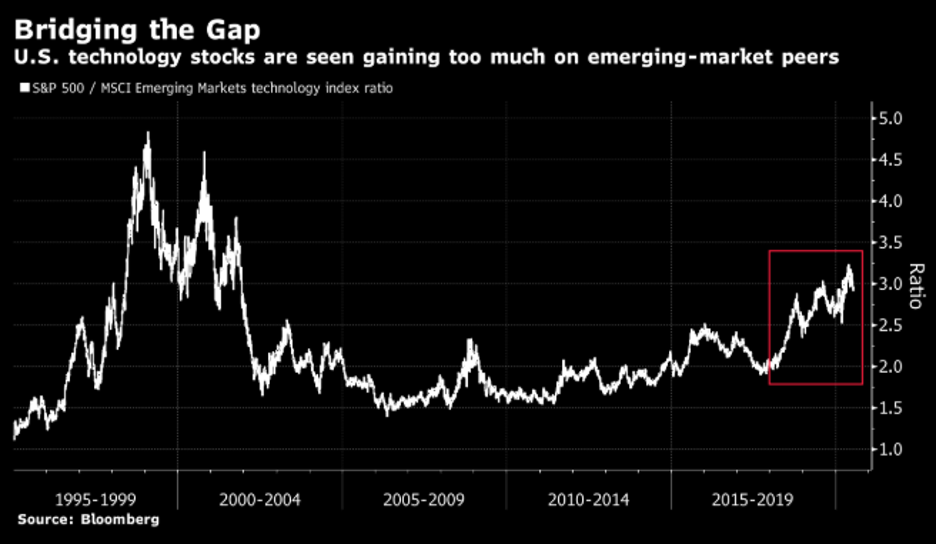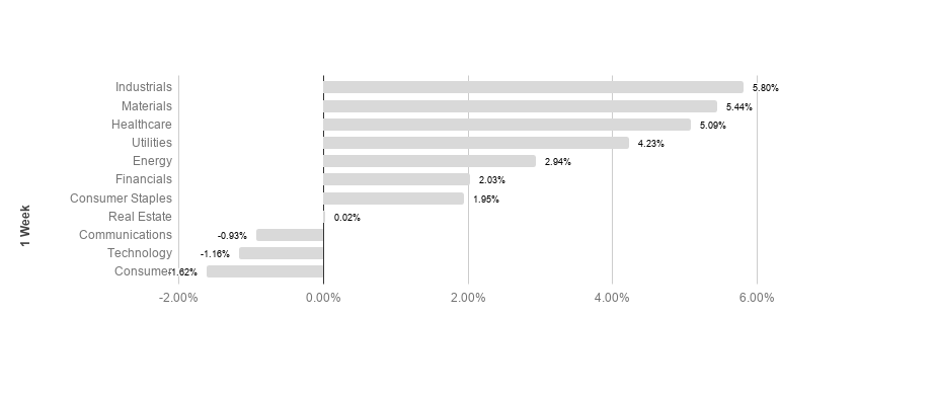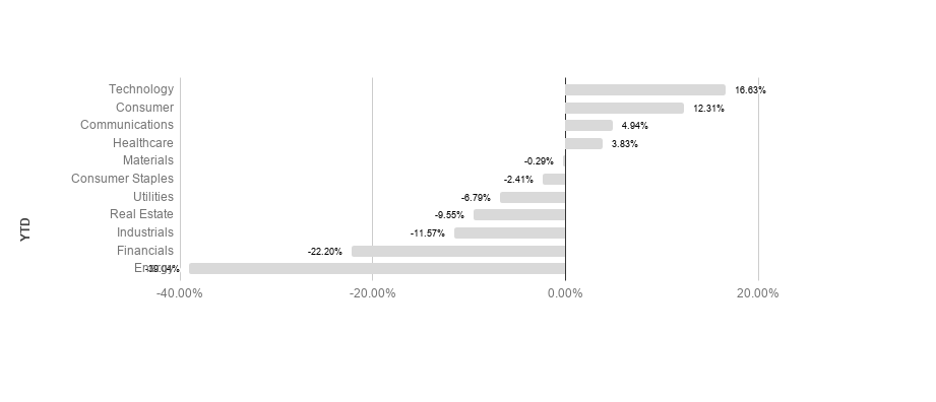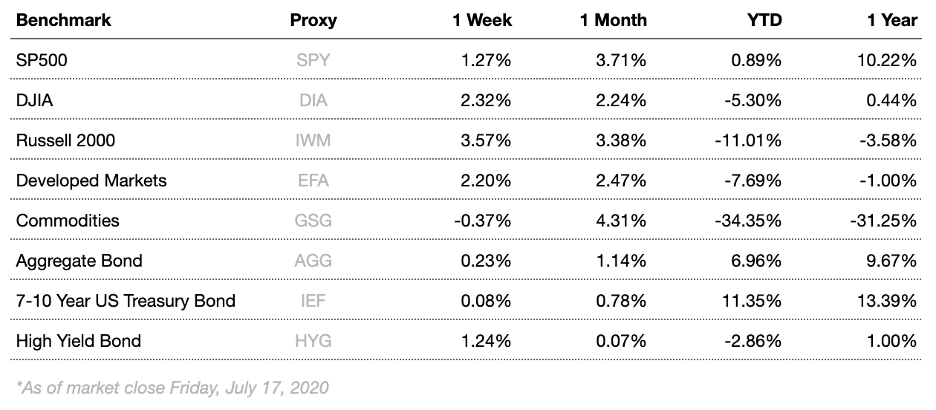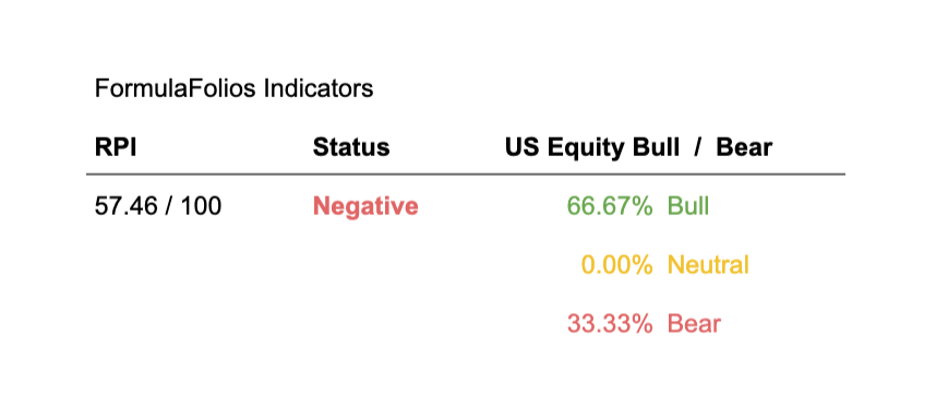Stocks rose again this week as economic data impressed for the second consecutive week. While new cases of Covid-19 have caused some states to begin restricting activities and infection rates seem to be increasing, new encouraging data has managed to support equities. Manufacturing and retail sales both moved in encouraging directions, returning results which beat expectations, helping to propel equities to finish the week in the positive. Manufacturing progress and dramatically improved retail sales has encouraged investors, as both factors have a significant impact on the economic environment. Retail sales has nearly recovered to its pre-pandemic levels, possibly indicating that a recovery in consumption is further along than expected. The SP500 is officially above the level at which it started 2020. Going forward, markets will likely continue to be fixated first and foremost on the rate of recovery and any risks that pose a threat to its trajectory. Tensions with China continue to be an unknown and will be watched carefully by analysts. Unemployment claims are likely to remain elevated for several more weeks, and the unemployment rate remains at the second highest level in history. The slowing of the opening process in the southern U.S. remains highly concerning, as infections are on the rise regionally. Also on the horizon is the expiration of the enhanced employment benefits which are due to expire at the end of July. Further economic data in the coming weeks and months will hopefully shed further light on true economic conditions and help provide an accurate outlook for the pace of the economic recovery.
Overseas markets rose, as encouraging U.S. data and negotiations surrounding a stimulus package in the EU helped lift equities. All major European indices returned positive results for the week. Japanese equities also returned positive performance. As global economies continue to work towards reopening, analysts are hoping Covid-19 infections are brought back under control so that focus can dial in more on global recovery efforts.
Markets rose this week, with most equity indices bringing in positive returns. Fears concerning global stability and health are an unexpected factor in asset values, and the recent volatility serves as a great reminder of why it is so important to remain committed to a long-term plan and maintain a well-diversified portfolio. When stocks were struggling to gain traction last month, other asset classes such as gold, REITs, and US Treasury bonds proved to be more stable. flashy news headlines can make it tempting to make knee-jerk decisions, but sticking to a strategy and maintaining a portfolio consistent with your goals and risk tolerance can lead to smoother returns and a better probability for long-term success.
Chart of the Week
U.S. tech firms continue to dominate emerging market competitors in market capitalization, now showing premiums not seen since the tech bubble in the early 2000s. Some fear that U.S. firms may be overvalued by comparison and are at risk of a correction.
Market Update
Equities
Broad market equity indices finished the week mostly up, with major large cap indices underperforming small cap. Economic data has continued to impress, but the global recovery still has a long way to go to regain lost jobs and output.
S&P sectors returned mostly positive results this week, as broad market movements showed investors buying most sectors. Industrials led the best performing sectors, followed by materials, returning 5.802% and 5.44% respectively. Technology and consumer discretionary performed the worst, posting -1.16% and -1.62% respectively. Technology leads the pack so far YTD, returning 16.63% in 2020.
Commodities
Commodities fell this week, driven by losses in natural gas. Energy markets have been highly volatile, with oil investors focusing on output and consumption concerns. Recent economic improvements have lifted demand outlook, as summer is likely to increase consumption while normal economic activities should continue recovering. Demand is still likely to recover slowly however, as economic activity is not likely to recover instantly. Oil supplies have shrunk dramatically, as operating oil rigs have shrunk by nearly 70% since last year, further helping oil prices to recover.
Gold rose this week as markets reacted to both increasing Covid infections and encouraging economic numbers. Gold is a common “safe haven” asset, typically rising during times of market stress. Focus for gold has shifted to global macroeconomics and recovery efforts. Weakening real currency values resulting from massive stimulus measures may further support gold prices.
Bonds
Yields on 10-year Treasuries fell from 0.64% to 0.62% while traditional bond indices rose. Treasury yield movements reflect general risk outlook, and tend to track overall investor sentiment. Treasury yields will continue to be a focus as analysts watch for signs of changing market conditions.
High-yield bonds rose this week, causing spreads to tighten. High-yield bonds are likely to remain volatile in the short to intermediate term as the Fed has adopted a remarkably accommodative monetary stance and investors flee economic risk factors, likely driving increased volatility.
Lesson to Be Learned
“The individual investor should act consistently as an investor and not as a speculator. This means … that he should be able to justify every purchase he makes and each price he pays by impersonal, objective reasoning that satisfies him that he is getting more than his money’s worth for his purchase.”
-Ben Graham
We have two simple indicators we share that help you see how the economy is doing (we call this the Recession Probability Index, or RPI), as well as if the US Stock Market is strong (bull) or weak (bear).
In a nutshell, we want the RPI to be low on the scale of 1 to 100. For the US Equity Bull/Bear indicator, we want it to read least 66.67% bullish. When those two things occur, our research shows market performance is strongest and least volatile.
The Recession Probability Index (RPI) has a current reading of 77.46, forecasting a higher potential for an economic contraction (warning of recession risk). The Bull/Bear indicator is currently 66.67% bullish – 33.33% bearish, meaning the indicator shows there is a slightly higher than average likelihood of stock market increases in the near term (within the next 18 months).
The Week Ahead
This week will see updated manufacturing PMI numbers. This release will help shed light on manufacturing conditions and could have an impact on equities.
More to come soon. Stay tuned.


